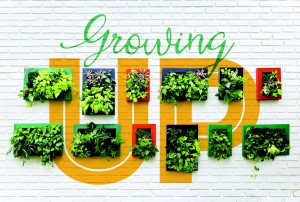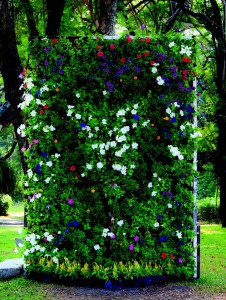Growing Up: Vertical Gardening Is Fun for All Ages
 Vertical gardens are sprouting up everywhere, from hip retail spaces to restaurant walls. Why is this trend growing so fast? Hanging pots filled with colorful flowers can beautify a bare wall, and stacked planters positioned along a fence or property line can create privacy. This space-saving gardening method also reduces the need to weed and keeps pests away from valuable veggies. A vertical garden can be as simple as a few towers of tomatoes in a sunny spot or as elegant as a living wall of succulents forming a focal point within a landscape.
Vertical gardens are sprouting up everywhere, from hip retail spaces to restaurant walls. Why is this trend growing so fast? Hanging pots filled with colorful flowers can beautify a bare wall, and stacked planters positioned along a fence or property line can create privacy. This space-saving gardening method also reduces the need to weed and keeps pests away from valuable veggies. A vertical garden can be as simple as a few towers of tomatoes in a sunny spot or as elegant as a living wall of succulents forming a focal point within a landscape.
Fun for All
Vertical gardens work well for families, because each person can dig into a section within easy reach. Tots can tend to a few small pots at eye level, and teens can have free reign over the upper section. Studies show that kids who grow their own vegetables are more likely to eat them, and having the garden off the ground also means that Fido (or outside nighttime critters) can’t dig up all your hard work. While you’re helping your kids grow up, this fun, DIY project can set the family team-building efforts in the right direction.
Vertical gardens also work well for groups or a public setting—a chain link fence at school, church, or community building is a blank canvas just waiting to be painted with bright blooms or savory produce. The ability to garden upright means less bending and stooping for those with mobility issues, and vertical gardens can be designed to be wheelchair-friendly. Indoor vertical gardens are also ideal for wannabe gardeners who prefer to limit their sun exposure.
Getting Started
A wall or fence that gets plenty of sunlight is the perfect spot to “grow up.” If you wish, you can also choose freestanding units or towers which have the added benefit of being portable if they are on wheels.
Most home improvement stores carry a selection of supplies to get you started, but your best bet is to visit a local garden store for expert advice. Palmer’s Garden & Goods in Orlando, for example, is a great place to start for helpful advice and supplies. They carry small, plastic living walls with ready-to-fill slots, half-round ceramic pots that can be attached anywhere, and Woolly Pockets; modular, pocket-style planters that are perfect for creating a vertical garden. “The pockets are great, because once they get filled with plants, you can’t see them,” said Linda Matheny, Palmer garden center manager. If using plastic, multi-cell, vertical planters, Matheny recommends leaving them flat for a few weeks before hanging them to allow the plants to take root. This is especially true with succulents, which have a shallow root structure.
For an indoor living wall, Matheny suggests choosing plants that need less light, like Pothos, a low-maintenance, lush vine. “You can also use spider plants, and arrange them on shelves. They are great at cleaning the air and removing toxins,” she said. If you have toddlers or pets, choose carefully, as some indoor plants can be toxic if consumed.
While pre-fab kits are an easy way to start, a vertical garden can be created with inexpensive supplies you might already have on hand. An old ladder and unused containers can become an instant herb garden; recycled 2-liter soda bottles can be fashioned into planters and hung from a clothesline. A shoe organizer has pockets perfect for plants, and even discarded dresser drawers can be filled with vibrant blooms. Use zip ties to attach small zinc buckets filled with plants to a lattice panel or wire mesh fencing secured to a wall. Why not get the kids involved and let them decorate the planters beforehand? Just use your imagination—the sky’s the limit when it comes to vertical gardening!
BONUS: What to Plant Now
Edibles: Purple basil, tarragon, rosemary, parsley, oregano, cucumbers, melons, tomatoes, pole beans, bush beans, peppers, rainbow chard, eggplant, okra
Ornamentals: Marigolds, Coleus, Sweet Alyssum, petunias, snapdragon, begonias, orchids, jade plants, bromeliads, colorful succulents, ornamental grasses








